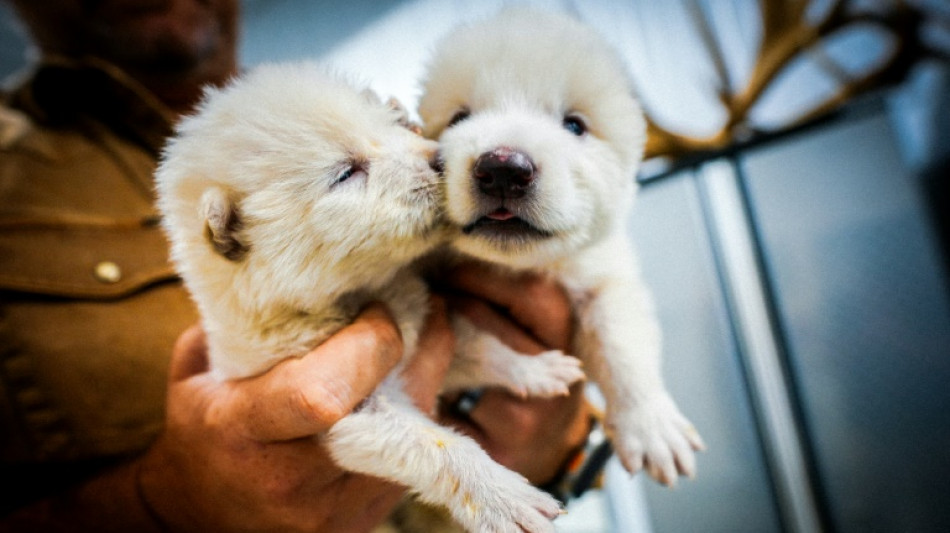
-
 Arsenal's Havertz could return for Champions League final
Arsenal's Havertz could return for Champions League final
-
US officials split on Ukraine truce prospects
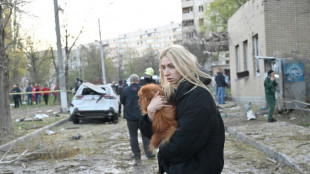
-
 Client brain-dead after Paris cryotherapy session goes wrong
Client brain-dead after Paris cryotherapy session goes wrong
-
Flick demands answers from La Liga for 'joke' schedule

-
 'Maddest game' sums up Man Utd career for Maguire
'Maddest game' sums up Man Utd career for Maguire
-
Trial opens for students, journalists over Istanbul protests

-
 Gaza rescuers say Israeli strikes kill 24 after Hamas rejects truce proposal
Gaza rescuers say Israeli strikes kill 24 after Hamas rejects truce proposal
-
'Really stuck': Ukraine's EU accession drive stumbles

-
 'Not the time to discuss future', says Alonso amid Real Madrid links
'Not the time to discuss future', says Alonso amid Real Madrid links
-
74 killed in deadliest US attack on Yemen, Huthis say

-
 Southgate's ex-assistant Holland fired by Japan's Yokohama
Southgate's ex-assistant Holland fired by Japan's Yokohama
-
Vance meets Meloni in Rome before Easter at the Vatican
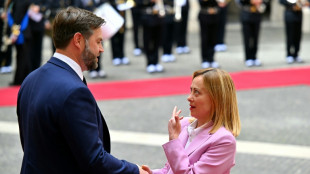
-
 Ryan Gosling to star in new 'Star Wars' film
Ryan Gosling to star in new 'Star Wars' film
-
Hamas calls for pressure to end Israel's aid block on Gaza

-
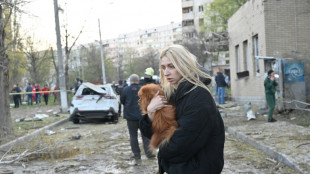 Russia says Ukraine energy truce over, US mulls peace talks exit
Russia says Ukraine energy truce over, US mulls peace talks exit
-
58 killed in deadliest US strike on Yemen, Huthis say

-
 Museums rethink how the Holocaust should be shown
Museums rethink how the Holocaust should be shown
-
Three dead after deadly spring storm wreaks havoc in the Alps

-
 No need for big changes at Liverpool, says Slot
No need for big changes at Liverpool, says Slot
-
Bloody Philippine passion play sees final performance of veteran 'Jesus'

-
 New US envoy prays, delivers Trump 'peace' message at Western Wall
New US envoy prays, delivers Trump 'peace' message at Western Wall
-
Postecoglou sticking around 'a little longer' as Spurs show fight in Frankfurt

-
 US threatens to withdraw from Ukraine talks if no progress
US threatens to withdraw from Ukraine talks if no progress
-
Tears and defiance in Sumy as Russia batters Ukraine border city

-
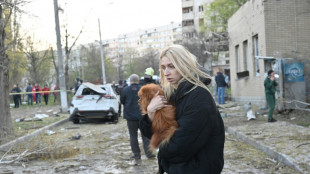 Russia rains missiles on Ukraine as US mulls ending truce efforts
Russia rains missiles on Ukraine as US mulls ending truce efforts
-
Tokyo leads gains in most Asian markets on trade deal hopes

-
 Two missing after deadly spring snowstorm wreaks havoc in the Alps
Two missing after deadly spring snowstorm wreaks havoc in the Alps
-
'War has taken everything': AFP reporter returns home to Khartoum

-
 US strikes on Yemen fuel port kill 38, Huthis say
US strikes on Yemen fuel port kill 38, Huthis say
-
Slegers targets Lyon scalp in pursuit of Arsenal European glory

-
 'Defend ourselves': Refugee girls in Kenya find strength in taekwondo
'Defend ourselves': Refugee girls in Kenya find strength in taekwondo
-
China's manufacturing backbone feels Trump trade war pinch

-
 Sri Lankans throng to Kandy for rare display of Buddhist relic
Sri Lankans throng to Kandy for rare display of Buddhist relic
-
Chinese vent anger at Trump's trade war with memes, mockery

-
 Heartbroken Brits abandon pets as living costs bite
Heartbroken Brits abandon pets as living costs bite
-
Mongolian LGBTQ youth fight for recognition through music, comedy

-
 Cash crunch leaves Syrians queueing for hours to collect salaries
Cash crunch leaves Syrians queueing for hours to collect salaries
-
Lyon left to regroup for Champions League bid after painful European exit

-
 Unravelling Real Madrid face Athletic Bilbao Liga test
Unravelling Real Madrid face Athletic Bilbao Liga test
-
Napoli disturbing buoyant Inter's peace in Serie A Easter bonanza

-
 Disappointed Dortmund chase consistency with Europe at stake
Disappointed Dortmund chase consistency with Europe at stake
-
Asian markets mixed as traders track tariff talks

-
 Yan and Buhai share lead at LA Championship
Yan and Buhai share lead at LA Championship
-
Under fire at debate, Canada PM Carney tries to focus on Trump

-
 Liverpool poised for Premier League coronation, Leicester, Ipswich for relegation
Liverpool poised for Premier League coronation, Leicester, Ipswich for relegation
-
India's elephant warning system tackles deadly conflict

-
 US senator meets wrongfully deported Salvadoran migrant
US senator meets wrongfully deported Salvadoran migrant
-
Gustavo Dudamel: the superstar conductor building bridges to pop

-
 Japan rice prices soar as core inflation accelerates
Japan rice prices soar as core inflation accelerates
-
US unveils new port fees for Chinese-linked ships


US firm says it brought back extinct dire wolves
They whimper, drink from baby bottles and crawl oh so tentatively -- they look like cute white puppies, not the fruit of a daring project to resuscitate an extinct species.
A Texas startup called Colossal Biosciences made a big splash this week by releasing footage of canines they say are dire wolves, a species that vanished more than 12,000 years ago.
"For the first time in human history, Colossal successfully restored a once-eradicated species through the science of de-extinction," the company states on its website.
Photos and video of these critters have flooded social media and shaken the scientific community, which has reacted with a mix of enthusiasm and skepticism over this experiment reminiscent of "Jurassic Park" -- the fictional story of a quirky rich man's attempt to bring back the dinosaurs.
The company says it did it by tweaking the DNA of a modern-day gray wolf with carefully chosen genes from dire wolf fossils. This modified genetic material was then inserted in a grey wolf egg and implanted in a common dog as a surrogate mom.
The result: three baby dire wolves, Colossal Biosciences claims.
"I think the claims are vastly overblown," Alan Cooper, an evolutionary molecular biologist who took part in a previous study of dire wolf DNA, told AFP.
"It would be like me putting a couple of genes into you from Neanderthals that made you extra hairy and grow more muscles, and then called you a Neanderthal," said Cooper.
"That's a million miles from Neanderthal. It's a hairy human."
"This is not the dire wolf. This is something they have created that has phenotypic characteristics of dire wolf,” said Lisette Waits, an ecologist and professor of wildlife resources at the University of Idaho.
Waits, who has worked extensively on grey wolf genetics and red wolf conservation issues, nonetheless called this achievement a breakthrough.
The pups are named Romulus and Remus, in a nod to the twin brothers of Roman mythology, and Khaleesi, of "Game of Thrones" fame.
- Debate -
The Colossal Biosciences team studied DNA from two dire wolf fossils -- a tooth from 13,000 years ago and a skull fragment dated back 72,000 years -- and compared them to the DNA of the gray wolf, a species that is alive and well.
The team concluded these two kinds of DNA are around 99.5 percent identical, Beth Shapiro, the company's chief science officer, told AFP.
An analysis of the differences between the two kinds of DNA determined which genes could be responsible for the dire wolf's size, muscle structure and its white fur.
With this information the team modified blood cells from a grey wolf by inserting some of those dire wolf genes. A total of 20 changes were made using the genetic manipulation technique known as Crispr-Cas 9, which is also used in human genetics.
The blood cells were then transferred to a gray wolf egg cell that was implanted in a dog. The results: Romulus, Remus and Khaleesi.
Whether these animals are actual dire wolves or simply genetically modified gray wolves, Shapiro insisted, "is a semantic, philosophical argument."
She added that it will never be possible to create an animal that is 100 percent genetically identical to a species that is extinct.
"But neither is that the goal. Our goal is to create functional equivalents of those species,” the scientist said.
- Dodos and wooly mammoths -
The company plans to apply this technique to dodo birds and woolly mammoths.
Just last month it released photos of mice injected with genetic material from one of those extinct pachyderms, yielding controversy and some very furry rodents.
Some scientists say the goal of recreating extinct species is unattainable and even dangerous. But others welcome it as an ambitious way to fight the planet's steady loss of biodiversity.
Waits, the conservation specialist, said that aside from the hoopla over this experiment this technique could help endangered species recover.
Colossal Biosciences has managed to lure more than $200 million in investment money, which would be a very tall task for other conservation causes, she added.
Ronald Sandler, a professor of philosophy and ethics at Northeastern University, said he worries this technique might lead to "moral distraction" away from the causes of animals going extinct, like climate change and habitat loss.
L.Maurer--VB




